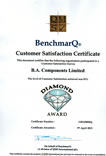- Home
- Tube Fittings by Sector
- Tube Fittings by Type
- BAC-LOK Assembly
- Assembly Instructions
- Male Connectors
- Male Elbows
- Male Run Tees
- Male Branch Tees
- Bulkhead Connectors
- Female Elbows
- Female Run Tees
- Female Branch Tees
- Equal Unions
- Unequal Unions
- Bulkhead Unions
- Union Elbows
- Female Connectors
- Union Tees
- Equal Unions Crosses
- Plugs
- Caps
- Male Adaptors
- Female Adaptors
- Reducers
- Bulkhead Adaptors
- Nuts
- Ferrules
- Lock Nuts
- Tubing Data
- Pipe Fittings
- Hose Fittings
- Contact Us
Food Manufacturing and Processing
One of the greatest challenges facing the food processing industry today is creating an environment that is safe and completely free of all harmful contaminants, toxins and bacteria. Over many years a variety of methods of cleaning and sanitizing food processing operations have been employed with varying levels of results. However, during this time certain preventative measures have proven themselves quite successful.
There are rigid rules to follow in keeping food processing free of harmful bacteria and pathogens. Properly cleaned work areas, adherence to strict hygienic standards and the use of easy to clean, bacteria resistant, stainless steel work equipment. When these ingredients are mixed together in the appropriate amounts, the result is a food processing operation that is sanitary and virtually pathogen-free.
The materials used in food processing equipment are critical, with stainless steel equipment, clearly positioned as the industry standard. Stainless steel carries many benefits: it is extremely easy to clean, corrosion- and scratch-resistant, and easy to sanitize. Grades 304 and 316 are the industry standard. However, some foods and their processes can be particularly aggressive. In such cases higher grades may be appropriate. Examples are duplex, super duplex, alloy 625 and C276.
In tests, stainless steels and its alloys has shown superior qualities in terms of resistance to damage, ease of cleaning, and effectiveness of cleaners, making it the material of choice. In the final analysis, there are a couple of ways to create and preserve the hygienic properties of your food-processing operation: cleaning and sanitizing all aspects of your supply line, and by using stainless steel equipment. By adhering closely to these principles, the incidence of bio-films and subsequent illnesses can be dramatically reduced, if not eliminated.

Food Processing

Food Manufacturing



